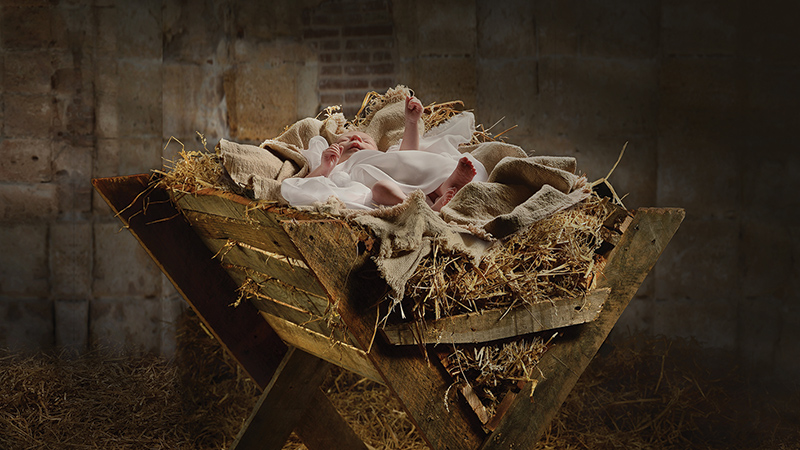The Trinity
December 1, 2017

In the late fourth century a young man born in Roman England was captured by marauders who brought him to Ireland and sold him into slavery. His name was Patrick, and you might never have heard of him were it not for the fact that during his captivity he learned about Christ and spent his enslaved years strengthening his faith through study and prayer. Eventually he was able to flee his owner and make his way back to Britain, where he undertook formal studies and was eventually ordained in France.
One day Patrick had a vision in which he heard the people of Ireland calling him: “We appeal to you, holy slave boy, to come and walk among us.” So Patrick returned to Ireland as a Christian missionary, baptising thousands, raising churches and ordaining priests. Though other missionaries had worked in Ireland, none of them were as successful as Patrick.
There are many stories and legends about Patrick, but one that’s especially beloved is how he taught his uneducated pagan hearers that God was One but also three Persons. He held up a sprig of clover—a plant that blankets the Emerald Isle. “This is three leaves, but also just one leaf,” he explained. “So it is with God. God is One, but that One is Three: Father, Son and Holy Spirit.”
A most puzzling doctrine
The proposition that God is composed of three distinct but equal and completely united Personalities—Father, Son and Holy Spirit—may be the most frequently discussed church doctrine in the history of Christianity. Strict monotheists, like Jews and Muslims, have misunderstood the three-in-one notion as evidence that Christians are polytheists worshipping multiple gods, much like the Hindus. Even Christian believers have wrestled with this idea. The 17th-century English minister Robert South wrote: “As he that denies this fundamental article of the Christian religion may lose his soul, so he that much strives to understand it may lose his wits.”
As important as it is to believe the teaching of the Trinity, I can assure you that it isn’t necessary to understand the precise mechanism of this blending of three Persons in one God. As with many things about God, it cannot be completely understood by mortal minds. What we can understand are the Persons of this Trinity and how they work together to show us God’s love.
The Father, Son and Spirit
To Israel, there was only one God. Surrounded by pagan nations with multiple gods and goddesses, God insisted that Israel confine itself to the one true God. “Hear, O Israel: The Lord our God, the Lord is one. Love the Lord your God with all your heart and with all your soul and with all your strength” (Deuteronomy 6:4). But even in the Hebrew scriptures there are hints that there is more to God than Creator, Nation-maker and Judge. The ancient Hebrew prophet Isaiah predicted the coming of a Messiah (Isaiah 7:14; 9:6) and laid out broad hints that He wasn’t going to be just another king, but Someone who would suffer on behalf of His people (Isaiah 53). Biblical character Job hinted at it, declaring: “I know that my redeemer lives, and that in the end he will stand on the earth” (Job 19:25).
Jesus’ arrival and claim to be the divine Messiah upset the settled belief that God could be understood in only one way. Jesus Himself was fully aware of the controversial nature of His identity; He usually avoided making clear public references to His divinity and largely relied on subtle hints.
Many of Jesus’ miracles and His teachings were so astonishing that even His enemies had to admit that He had an unusual relationship with God. When asked to describe that relationship, He said, “I and the Father are one” (John 10:30). This close identification with God so angered the Jewish leaders that they determined to crucify Jesus. But, unexpectedly, this gave Him the opportunity to prove His divinity by returning to life after being dead.
The Holy Spirit may be the most mysterious and difficult One to describe of the three Persons of the Godhead. Jesus referred to the Spirit as the Entity who would continue to provide guidance after He was gone: “I will ask the Father, and he will give you another advocate to help you and be with you forever—the Spirit of truth. The world cannot accept him, because it neither sees him nor knows him. But you know him, for he lives with you and will be in you” (John 14:16, 17).
There are enough biblical references to the work of the Holy Spirit that it’s clear that He isn’t just an indirect way to speak of God’s influence, but that He is an actual distinct Person.
The early Christian struggle
The Bible never uses the word Trinity, but there are a few New Testament references to the Father, Son and Holy Spirit as a combined Entity. Each of these Persons is described clearly, and all Three are often even mentioned in the same passage. A case in point is 1 Peter 1:2, in which the apostle said that his readers had been “chosen according to the foreknowledge of God the Father, through the sanctifying work of the Spirit, to be obedient to Jesus Christ and sprinkled with his blood.” And in Matthew 28:19, where Jesus told His disciples to baptise new disciples “in the name of the Father and of the Son and of the Holy Spirit,” the three Members of the Trinity are named in a sort of formula.
So with no straightforward theology of the Trinity in the Bible, early Christians struggled to know how to regard Jesus and the Holy Spirit. A few rejected Jesus’ divinity, but most of the early church leaders were convinced that He was God, exactly as He claimed to be.
"Jesus’ arrival and claim to be the divine Messiah upset the settled belief that God could be understood in only one way."
Church councils took up the question of the Trinity repeatedly during the early Christian history. One of the final products of their study, the fifth century Athanasian Creed, explained the Trinity while warning against polytheism. It described “one God in Trinity. . . . There is one Person of the Father, another of the Son, and another of the Holy Ghost. . . . They are not three Gods, but one God. . . . So are we forbidden by the Catholic Religion to say, There be Three Gods.”
In these few words the early Christian scholars showed that even if God is triune, these three parts aren’t separate. To think that you must pray to God for one thing and Jesus for another or to act as though the Three are in competition with One Another is to misunderstand completely the doctrine of the Trinity. You can pray to any of Them and that prayer is heard by All. You can neither divide Them nor love One more than Another.
Functionally speaking
Perhaps the best way to explain the three parts of God is to see Them in Their purpose in our salvation.
God the Father is the Foundation and Originator of everything (Genesis 1:1). I like the description of God by the hymn writer Walter C Smith, who wrote: “Immortal, invisible, God only wise / in light inaccessible hid from our eyes / most blessed, most glorious, the Ancient of Days / almighty, victorious, Thy great name we praise.”
As we look 25 through the Old Testament, we see Him as a strong Force, a Guide, a Disciplinarian. And God is indeed all of these things.
But a God like that—immortal, invisible, inaccessible—isn’t necessarily easy for us finite beings to relate to. When it came time to implement the plan of salvation, God needed “one like a son of man” (Revelation 14:14) to be a Healer, a Teacher and a mortal Sacrifice. As a man, Jesus was “tempted in every way, just as we are—yet he did not sin” (Hebrews 4:15). God was seen in the Person of Jesus as merciful and gracious, One who loves sinners, has power over death, and who in heaven mediates our prayers to His Father (1 Timothy 2:5).
As Jesus predicted, the Spirit speaks to us in subtle ways through our minds and emotions. Early Christians emphasised that the Holy Spirit inspired the authors of the Bible (2 Peter 1:21) and guides us as we study it (John 16:13). This enables us to worship and fellowship together as Christians (2 Corinthians 13:14). The Holy Spirit is the voice of our conscience (Romans 9:1). He gives us spiritual talents (1 Corinthians 12:7) and provides the power we need to overcome our sins (2 Timothy 1:7).
Seen in this way, the Holy Trinity presents God to us in three distinct Persons, each intended to be accessible to human beings with our differing personalities and needs.
Yet don’t misunderstand: That I can see the Holy Spirit changing my life doesn’t mean that Jesus is uninterested in my growing in grace. That Jesus served as the Sacrifice for my sins on the cross doesn’t mean that God doesn’t love me just as much. That God is the judge of sin doesn’t mean that Jesus or the Spirit are unconcerned about it. They are indeed Three in One, and all Three love you and me.

Hints on Jesus' identity . . .
- He does the actions of God—forgives sins (Mark 2:1–12, Luke 7:36–50); judges (Matthew 25:31–34, John 9:39).
- He has the aliases of God—the First and the Last (compare Isaiah 44:6 and Revelation 22:12–16); I Am (compare Exodus 3:14 and John 8:58).
- He has God’s attributes—sinless (Luke 23:41, 2 Corinthians 5:21); eternal (John 1:1–5, 14).
- He is addressed as God—by Thomas (John 20:28), in the psalms (Hebrews 1:8), by the prophets (Isaiah 9:6).
- He admits He is God—to Peter (Matthew 16:16–18, note that “Son of God” is considered equal to God, John 5:18).
- He is adored as God—by the healed blind man (John 9:35–38), by the angels (Hebrews 1:6).













